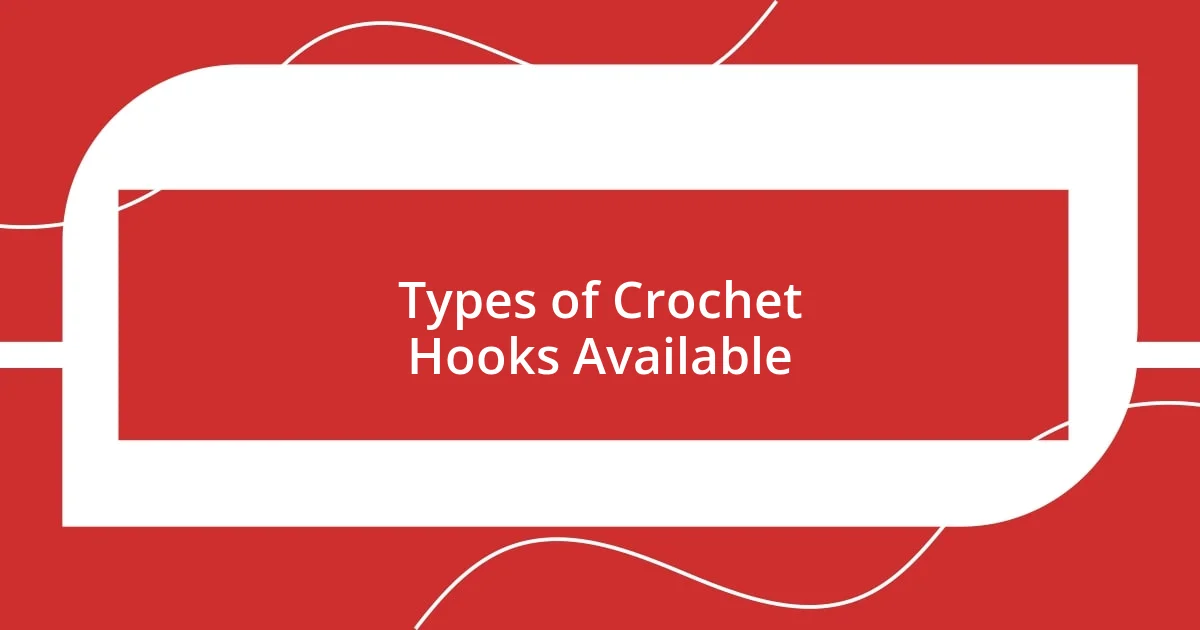Key takeaways:
- Crochet hooks vary by size, material, and shape, each affecting the texture and ease of your work.
- Choosing the right hook size involves matching it to yarn weight, considering stitch type, personal tension, and the project’s purpose.
- The hook’s material significantly influences comfort and grip; options include aluminum, wood, and bamboo, each offering unique benefits.

Understanding Crochet Hook Basics
When I first began crocheting, I remember standing in front of a wall of crochet hooks, feeling completely overwhelmed. The variety, in terms of size and material, made my head spin. Understanding that crochet hooks are primarily categorized by their size – which affects the stitches and ultimately the texture of your work – was a game changer for me.
The material of the hook can also significantly influence your experience. For instance, I find that aluminum hooks glide smoothly through yarn, which is great for beginners. But have you ever tried using a wooden hook? The warmth of the wood adds a unique touch, and I often feel a personal connection to my work when using them. What’s your preference when it comes to the feel of the hook in your hand?
Another fundamental aspect to consider is the hook’s shape. I’ve noticed that some hooks have a tapered design, which can really help with intricate stitches, while others are more tapered at the tip, making it easier to pick up yarn. It often comes down to personal comfort and the projects you’re most passionate about. Isn’t it fascinating how such small differences can impact your entire crocheting journey?

Types of Crochet Hooks Available
When it comes to crochet hooks, they come in various types, each with unique features that can enhance your crocheting experience. There are standard hooks made from materials such as aluminum, plastic, and wood. For instance, I once tried a plastic hook and found it surprisingly lightweight, which was perfect for long sessions. However, I also experienced slight slippage when working with slippery yarn, so it’s always crucial to match the hook with the yarn type.
A more specialized type of hook is the ergonomic hook, designed to reduce hand strain during lengthy projects. I remember the first time I used an ergonomic hook; the comfort it provided completely transformed my crocheting experience. It made me realize how important it is to choose a hook that feels right, especially if you want to keep enjoying this craft for hours on end. Additionally, there are also specialty hooks, like Tunisian crochet hooks, which have a longer shaft and allow for a distinct stitch style. Have you ever ventured into Tunisian crochet? The texture it creates is truly mesmerizing!
Lastly, let’s not overlook the size of the hook, which is denoted by numbers or letters. Each size corresponds to the yarn weight, impacting the stitch density of your project. I’ve learned that even a slight difference in hook size can lead to varying results in my projects. It’s often a bit of trial and error, but it’s all part of the creative journey!
| Type of Hook | Description |
|---|---|
| Standard Hooks | Made from aluminum, plastic, or wood; versatile for various projects. |
| Ergonomic Hooks | Designed for comfort; reduces hand strain during extended use. |
| Tunisian Hooks | Longer shafts for creating unique stitching styles distinctive to Tunisian crochet. |
| Specialty Hooks | Includes hooks like double-ended, great for specific crochet techniques. |

How to Determine Hook Size
Determining the right hook size for your project can be a delightful yet daunting task. I often start by looking at the yarn label, which typically suggests a recommended hook size. This is a good rule of thumb, but I’ve found that experimenting with different sizes can reveal delightful surprises. On one occasion, I was working on a cozy blanket and decided to use a larger hook than recommended. The result was an airy texture that I absolutely loved, despite it not being what I originally intended!
To ease the process of choosing the correct hook size, consider these factors:
- Yarn Weight: Match the hook size to the yarn’s weight. Bulky yarn needs a bigger hook, while lace weight yarn requires a smaller one.
- Stitch Type: Different stitches can behave differently. For instance, intricate stitches might necessitate a more precisely sized hook.
- Personal Tension: Pay attention to how tightly or loosely you crochet. I’ve discovered that my tension can vary, and adjusting the hook size helps achieve the desired result.
- Project Purpose: Consider the final piece. A loose scarf might look better with a larger hook, while a fitted garment might require a tighter stitch.
Each project is a learning experience, and I always enjoy the little surprises along the way!

Materials and Their Benefits
When selecting a crochet hook, the material truly plays a pivotal role. For instance, I’ve often reached for aluminum hooks because they glide effortlessly through yarn. Acrylic or plastic hooks, while lighter, sometimes make me feel like my yarn slips a bit too much, especially with slippery fibers. Have you experienced that frustrating moment when your hook just doesn’t hold onto the yarn the way you’d like? That’s a clear signal to experiment with different materials.
Wooden hooks have a unique warmth and weight that I find incredibly satisfying. I remember crocheting a scarf with a beautiful hardwood hook; the tactile experience was almost meditative. Plus, wood tends to create a bit more friction, which helps maintain stitch control. It’s fascinating how something as simple as the hook’s material can alter not only the ease of crochet but also the overall feel of the project.
On the other hand, I’ve recently discovered bamboo hooks, which combine the best of both worlds: they’re lightweight and provide just the right amount of grip. I can’t tell you how often I’ve been rewarded with smooth, even stitches because of the way bamboo hooks interact with my yarn. If you haven’t tried one yet, I highly recommend it; it might just make your next crochet project a dream come true!

Assessing Hook Comfort and Grip
When it comes to assessing hook comfort and grip, I always prioritize how a hook feels in my hand. There’s something so satisfying about a hook that feels just right! I remember one time I picked up a tulip-shaped hook, and it felt like it was made for my fingers. The ergonomic design cradled my hand perfectly, making those long crafting sessions a breeze.
Grip can be a game-changer in your crochet experience. Have you ever struggled with a hook that feels slippery? I certainly have! I once tried crocheting with a shiny, metal hook that kept slipping out of my grasp. It led to a frustrating series of frogged stitches—which is a fancy term for undoing what you’ve crocheted. Since then, I look for hooks that provide a bit more texture or even a rubberized grip. Such features can make all the difference, keeping my hand relaxed while I work.
Another aspect I consider is the hook’s diameter and length. A thicker grip can alleviate tension in my hand, especially during extended projects. I recall a marathon crochet session where I switched from a standard hook to one with a wider handle. What a relief that was! It turned an ordinary evening into a cozy, enjoyable experience. So when selecting a crochet hook, remember that comfort and grip are not just personal preferences; they’re essential for creating without strain!















